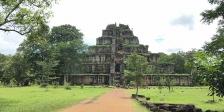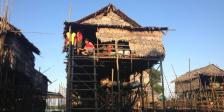Cambodia is the land of the Khmer, the dominant ethnic group in the area stretching from the present deep into prehistory. The Angkorian era Khmer Empire centered near Siem Reap dominated the region from the 9th-13th century AD, at its apex the Empire stretched across most of mainland Southeast Asia. But by the 15th century the Empire was in political and territorial decline and under challenge from the rising Tai kingdom of Ayudhaya in today’s Thailand. By the 14th century Ayudhaya was staging regular incursions, culminating with the sack of Angkor in 1431-32. Shortly thereafter the Khmer court of King Pohea Yat left the Angkorian capital and established a new capital at Phnom Penh. With a very brief exception, the capital would never return to Angkor. The choice to move the capital to Phnom Penh at the confluence of the Mekong was probably not only a strategic response to Ayudhhaya’s aggression but may have also reflected a tectonic economic shift. The 15th century was the beginning of a general rise in international commerce throughout the region and Phnom Penh was an ideal location for a trade center. The move may have reflected the country changing focus from the old Angkorian agrarian economy based in the country’s interior to a trade oriented economy based in a riverine port town. During the first Royal occupation of Phnom Penh in the mid 15th century, King Pohea Yat set the foundations of city, establishing several wats and laying out the town along moats/rivers which approximate the area and layout of modern central Phnom Penh. Wat Ounalom on the riverfront near the Royal Palace may even slightly pre-date King Pohea Yat, making it the oldest known Buddhist foundation in the city.
Phnom Penh was found Lady Penh legend tell of a local woman, Old Lady Penh (Duan Penh,) living at the chaktomuk, the future Phnom Penh. It was the late 14th century and the Khmer capital was still at Angkor near Siem Reap 350km to the west. Gathering firewood along the banks of the river, Lady Penh spied a floating koki tree in the river and fished it from the water. Inside the tree she found four Buddha statues and one of Vishnu (the
numbers vary on different tellings.) The discovery was taken as a divine blessing, and to some a sign that the Khmer capital was to be brought to Phnom Penh from Angkor. To house the new found sacred objects, Lady Penh raised a small hill on the west bank of the Tonle Sap River and crowned it with a shrine, now known as Wat Phnom at the north end of central Phnom Penh. 'Phnom' is Khmer for 'hill' and the Lady Penh's hill took on the name of the founder, i.e. Phnom Duan Penh, and the area around it became known after the hill - Phnom Penh.
Trade with China and other Asian kingdoms was well established in the Angkorian-era long before Phnom Penh was the capital. Boats traveling upriver to Angkor would pass Chaktomuk (Phnom Penh) which, due to its favorable location, was probably an active settlement at the time. After the capital moved from Angkor to Phnom Penh in the mid 15th century, the city remained the capital only briefly. Before the century was out, the capital had been relocated to Longvek 46km upriver. Though it moved a few more times in the subsequent centuries (primarily between Longvek and Oudong,) the capital always remained within a few tens of kilometers of the Chaktomuk area. 

Maritime trade increased dramatically throughout the region in the late 15th century, with international players from as far as Japan. Though the capital had moved from Phnom Penh, the town remained the center of international commerce for Cambodia.
Sixteenth century Spanish and Portuguese records paint a picture of small but cosmopolitan port of trade hosting significant populations of Chinese, Malay, Cham, Japanese and some Europeans, all living in separate camps in and around the Phnom Penh area. Structures of wood and bamboo crowded the west bank of the Tonle Sap river and the great stupa on the hill of Wat Phnom was visible from the river, marking the town to arriving visitors. 

Arriving in the early 16th century, the Portuguese and Spanish were the first Europeans to make contact with Cambodia, sending missionaries, establishing trade and eventually becoming deeply involved in the affairs of the Cambodian court. At the center of the drama were two larger-than-life characters, Spaniard Blaz Ruiz, Portuguese Diogo Veloso and their band. Arriving in the 1580s they ingratiated themselves to the Cambodian King, served him as a sort of Praetorian guard, were captured and then escaped the Siamese, retuned and murdered the new Khmer leader, fled to Laos, installed a new Khmer king in Cambodia, and amidst rising tensions, both died in 1599 coming to the aid of their compatriots in a battle between the Malay and Cambodians against the Spanish in Phnom Penh. The battle resulted in a massacre of the Spanish, bringing Spanish influence in Cambodia to an abrupt and permanent end. 

In the 17th century, Phnom Penh continued to prosper and the Dutch East India Company became the dominant European trading partner, but this relationship also came to a dire end in Phnom Penh. In a tale less colorful than the Spanish adventure, after a lengthy trade and diplomatic dispute between the Dutch and the King of Cambodia, negotiations came to violence. A Company embassy was killed and captives taken. The Company sent war ships to force the issue with the King at Longvek. Once the ships had passed Phnom Penh on their way up the Tonle Sap, the Cambodians built two bridges across the river behind them, effectively blocking the river. Upon returning downstream the Dutch ships were trapped by the bridges at Phnom Penh and besieged by fire from both banks. They fought their way through in a day long battle but suffered very heavy losses. Like the Spanish, Dutch influence in Cambodia never recovered. Though the first British and French explorers would arrive in the mid 17th century, European interest in Cambodia wanted until the French in force returned in the late 19th century.


 Hot Line: +855 88 7272 445
Hot Line: +855 88 7272 445










.jpg)

